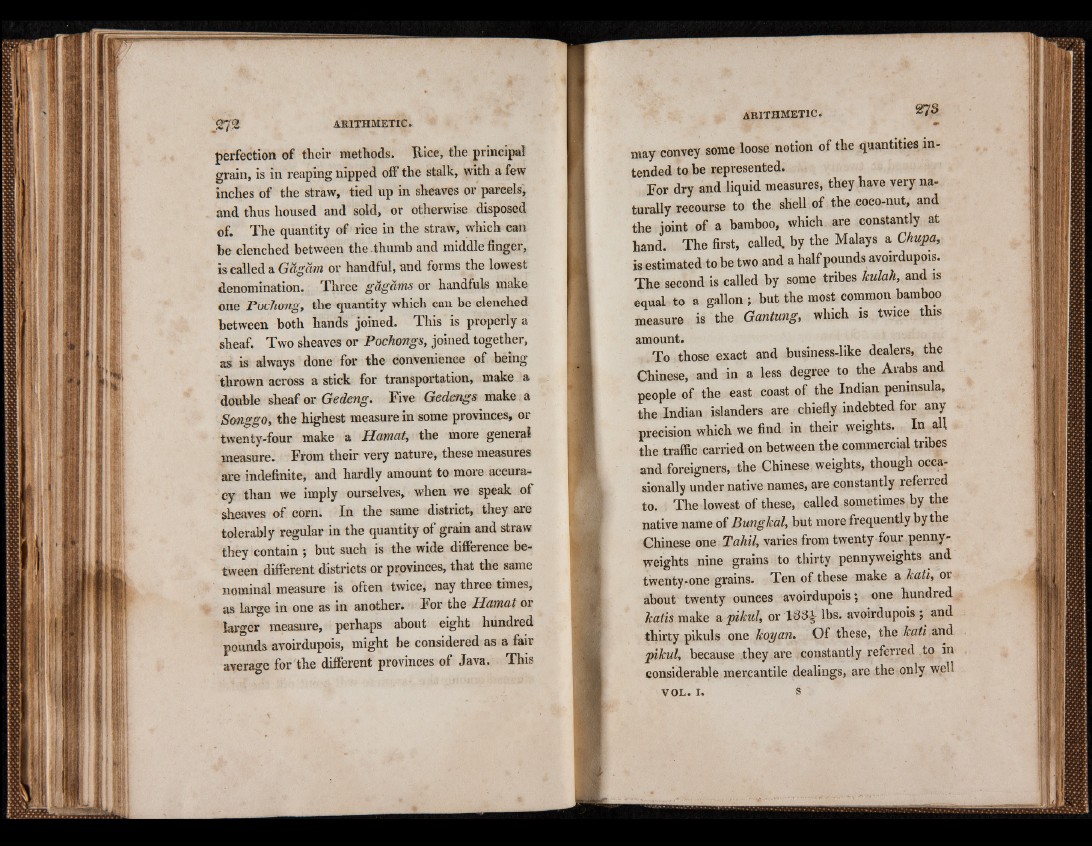
A RITHMETIC.
perfection of their methods. Hice, the principal
grain, is in reaping nipped off the stalk, with a few
inches of the straw, tied lip in sheaves or parcels,
and thus housed and sold, or otherwise disposed
of. The quantity of rice in the straw, which can
be clenched between the thumb and middle finger,
is called a Gag dm or handful, and forms the lowest
denomination. Three gdgdms or handfuls make
one Pochong, the quantity which can be clenched
between both hands joined. This is properly a
sheaf. Two sheaves or Pochongs, joined together,
as is always done for the convenience of being
thrown across a stick for transportation, make a
double sheaf or Gedeng. Five Gedengs make a
Songgo, the highest measure in some provinces, or
twenty-four make a Hamat, the more general
measure. From their very nature, these measures
are indefinite, and hardly amount to more accuracy
than we imply ourselves, when we speak of
sheaves of corn. In the same district, they are
tolerably regular in the quantity of grain and straw
they contain ; but such is the wide difference between
different districts or provinces, that the same
nominal measure is often twice, nay three times,
as large in one as in another. For the JH.avn.at or
larger measure, perhaps about eight hundred
pounds avoirdupois, might be considered as a fair
average for the different provinces of Java. This
m a y convey some loose notion of the quantities intended
to be represented.
For dry and liquid measures, they have very naturally
recourse to the shell of the coco-nut, and
the joint of a bamboo, which, are constantly at
hand. The first, called, by the Malays a Chupa,
is estimated to be two and a half pounds avoirdupois.
The second is called by some tribes kulak, and is
equal to a gallon ; but the most common bamboo
measure is the Gantung, which is twice this
amount. ,
To those exact and business-like dealers, the
Chinese, and in a less degree to the Arabs and
people of the east coast of the Indian peninsula,
the Indian islanders are chiefly indebted for any
precision which we find in their weights. In all
the traffic carried on between the commercial tribes
and foreigners, the Chinese weights, though occasionally
under native names, are constantly referred
to. , The lowest of these, called sometimes by the
native name of Bungkal, but more frequently by the
Chinese one Tahil, varies from twenty four pennyweights
nine grains to thirty pennyweights and
twenty-one grains. Ten of these make a kati, or
about twenty ounces avoirdupois; one hundred
katis make a pikul, or 183^ lbs. avoirdupois ; and
■thirty pikuls one koyan. Of these, the kati&nd
pikul, because they are constantly referred to in
considerable mercantile dealings, are the only well
v o l . 1. s